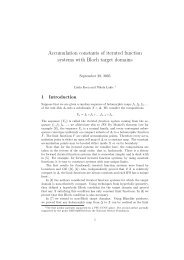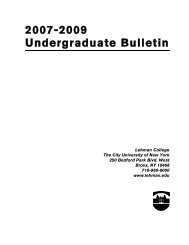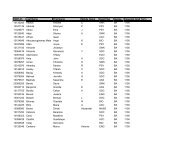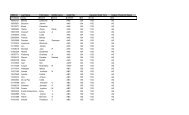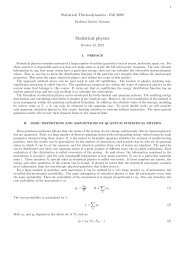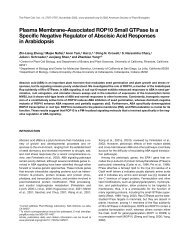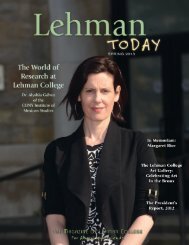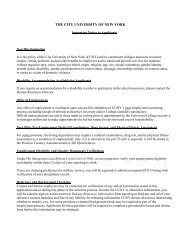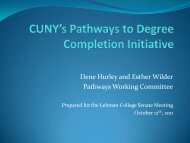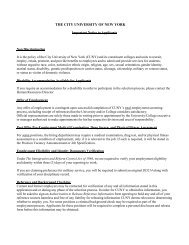Create successful ePaper yourself
Turn your PDF publications into a flip-book with our unique Google optimized e-Paper software.
Research<br />
Research by <strong>Lehman</strong> Faculty—and Students— Continues to Enlarge Our Knowledge<br />
In 2010, <strong>Lehman</strong> faculty and students added to our understanding of the environment, healthcare,<br />
education, and a host of other issues. Here is just a sampling.<br />
Professors Marilyn Aguirre-<br />
Molina and Luisa N. Borrell<br />
(Health Sciences) published the first<br />
research to put the health concerns<br />
of Latino men into a broader context.<br />
Race, in particular, they found, is a<br />
powerful factor in determining an<br />
individual’s health status.<br />
Dr. Stuart Chen-Hayes (Counseling,<br />
Leadership, Literacy, and Special<br />
Education) spearheaded the creation of<br />
a new DVD that is the first to focus on<br />
equity-based school counseling, with an<br />
emphasis on ensuring academic, career,<br />
and college success for all the nation’s<br />
K-12 students.<br />
Recent research by Reem Jaafar, a physics<br />
doctoral student at <strong>Lehman</strong>, may ultimately<br />
lead to faster computers and larger memories.<br />
She studied spin-rotation effects in a<br />
magnetic molecule that is bridged between<br />
two conducting leads and presented a new<br />
quantum theory for measuring the movement<br />
of such a molecule in an electrical circuit. A magnetic molecule<br />
is the smallest nanomagnet that one day can become part of a<br />
computer memory unit.<br />
Professor Edward Kennelly’s lab (Biological<br />
Sciences) has developed a process<br />
to help identify the phytochemical fingerprint<br />
of black cohosh, a plant widely used to treat<br />
the symptoms of menopause.<br />
Professor Sandra Levey<br />
(Speech-Language-Hearing Sciences) put years<br />
of research and classroom experience into her<br />
book to help teachers with their students who<br />
speak a language other than English. The number<br />
of those students already stands at five million.<br />
Professor John Locke (Speech-Language-<br />
Hearing Sciences) published a new book in<br />
which he examines the evolution of eavesdropping<br />
and traces its history from the<br />
intense surveillance of the hunter-gatherers<br />
to celebrity watching and our use of social<br />
media like Facebook and Twitter. <br />
The Uganda Landslides:<br />
How One <strong>Lehman</strong> Professor Is Helping to<br />
Prevent Future Disasters<br />
Almost 300 people were buried alive on March 1, 2010 when<br />
a landslide struck their village in Nametsi, Uganda. Dr. Yuri<br />
Gorokhovich (Environmental, Geographic, and Geological<br />
Sciences) visited the area last summer<br />
and is using high-resolution<br />
satellite imagery to assess the stability<br />
of the mountain slope on which the<br />
village rests and better predict future<br />
landslides. With this latest analysis, he<br />
found that twenty-nine households<br />
were in the immediate path of the next<br />
potential landslide.<br />
To help prevent another<br />
disaster, he proposed<br />
that a series of vertical<br />
bars be placed in rows<br />
both above and below<br />
the scarp on the mountainside,<br />
which would<br />
be monitored twice a<br />
month, especially during<br />
the rainy season, to track<br />
the rate of the landslide<br />
movement. Using this<br />
simple monitoring system,<br />
researchers could<br />
then predict the speed of<br />
Professor Gorokhovich (top) created<br />
this map, with a satellite image<br />
provided by eMap International<br />
(www.emap-int.com).<br />
the landslide movement, as well as the effect of rain on landslide<br />
development. Analyzing high-resolution satellite imagery,<br />
along with village records of landslide occurrence, and field<br />
investigations can establish landslide-prone zones.<br />
Residents from Nametsi and thirteen surrounding villages<br />
were displaced to a camp area that is now functioning at more<br />
than double the capacity, and with very limited resources,<br />
leaving people from high-risk areas with nowhere to go for<br />
refuge. This research will help villagers avoid future disasters<br />
and human casualties.<br />
38 <strong>Lehman</strong> Today/<strong>Spring</strong> <strong>2011</strong>



